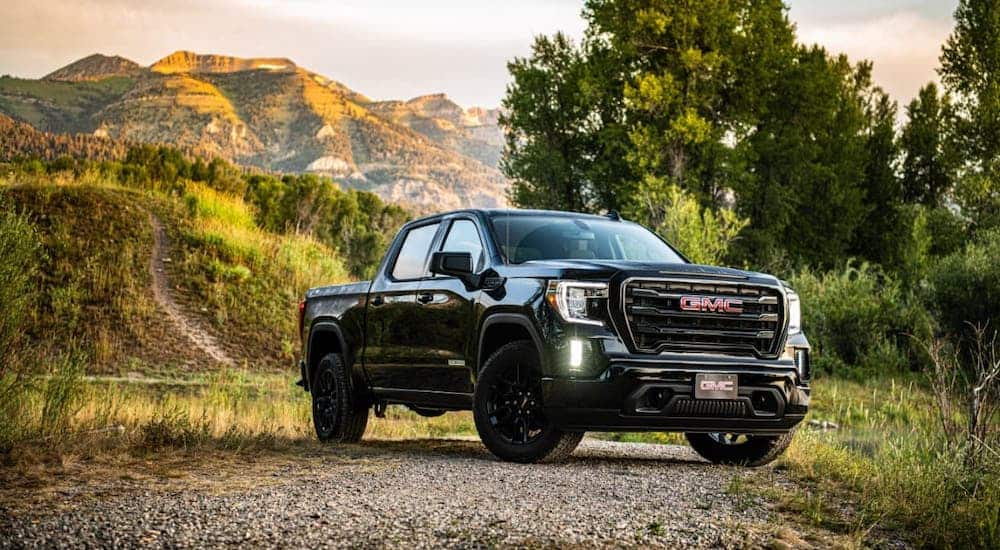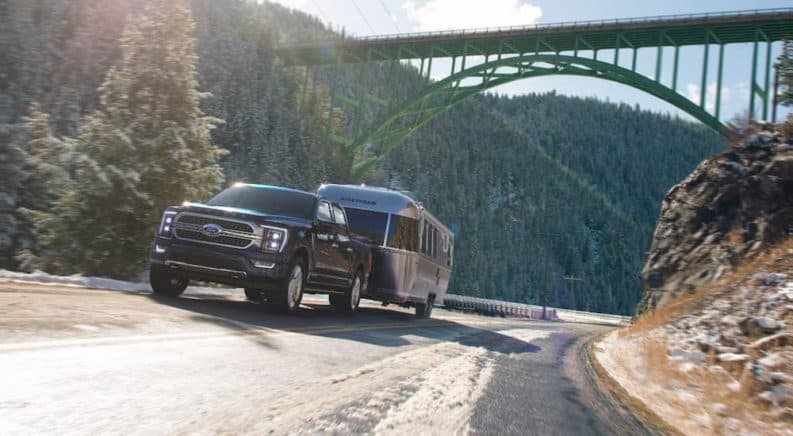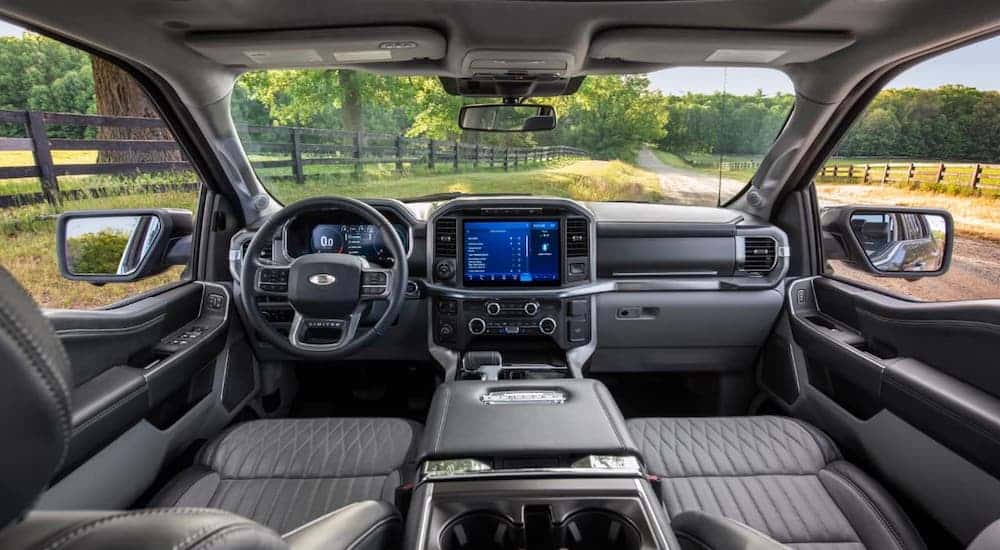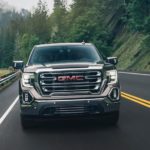Over a century after it started, the Ford versus General Motors rivalry is still going strong. This is especially true in the full-size pickup market, where GM has continually tried to dethrone the perennially best-selling F-150. Today we’re going to be looking at the 2021 Ford F-150 vs 2021 GMC Sierra 1500 to see who is currently on top of this ancient rivalry.
In general, the GMC Sierra aims for a noticeably higher price point and market segment than the F-150, which seemingly has an array of different variants for every day of the week. While the Sierra is often more expensive, the F-150 does have variants and trims available that can match any Sierra in price point and appointed amenities. Let’s dig into each truck and see which one is truly ahead of the competition.
Engines: The Power Behind the Truck
One of the most important parts of any vehicle is the engine. This is especially true of pickups, where the engine determines their ability to tow far more than their own weight and haul large payloads. Both F-150 and Sierra have some impressive engine choices, but the F-150 does have more desirable levels of power and a more comprehensive range of options, putting it a step ahead in this competition. Let’s break down the engine options, so you can see what we mean.

The Engines of the Ford F-150
The smallest available engine for the F-150 is the 2.7-liter turbo V6. This engine is twin-turbo, with aluminum heads and a strong iron block. While it is well known in the tuning community for its excellent potential, even from the factory, it boasts an impressive 325 horsepower and a full 400 lb-ft of torque. Keep in mind that this is the smallest engine available; however, that does not mean it is the weakest. This engine produces more than enough power to enable the F-150 to tow up to 10,100 pounds depending on the options selected.
The next largest engine option is the 3.0-liter turbo-diesel V6. Even though this engine is on the smaller side and has just a single turbocharger, thanks to its diesel-powered nature, it generates 250 horsepower and up to 440 lb-ft of torque. Great for hauling payloads and towing up to 12,100 pounds, this Power Stroke V6 makes heavy work seem light.
The next largest engine option is the 3.3-liter naturally aspirated V6. Even though this engine is on the smaller side and is without turbochargers, it still produces an impressive 290 horsepower and 265 lb-ft of torque, which is more than enough for most operators. This is the “weakest” engine in the lineup, but don’t be fooled by that. This engine can still tow up to 8,200 pounds and support a payload of up to 1,985 pounds.
The 3.5-liter twin-turbo Ecoboost V6 is a staple Ford engine and has come to power several Ford vehicles. This reliable workhorse produces a significant 400 horsepower and an eye-widening 500 lb-ft of torque. This is the engine you need if you want to get the most out of the Ford F-150, with a towing capacity of up to 14,000 pounds.
The next engine is also a 3.5-liter turbocharged V6, but it is of a whole new variety for the F-150. This is the truck’s first hybrid engine, and it produces a ridiculous 430 horsepower and 570 lb-ft of torque. You can tow up to 12,700 pounds with it, and the hybrid powertrain gives this model excellent gas mileage.
The final and largest engine option of the many available for the F-150 is the 5.0 Coyote V8 commonly found in the Mustang. Slightly modified for the F-150 application, this beefy V8 can grunt out a total of 400 horsepower and 410 lb-ft of torque. This powerplant has been a standout Ford product for years now and continues to put in admirable work in the F-150.
The Engines of the GMC Sierra
While the F-150 has six engine options to parse through, the Sierra has a total of five, with the more powerful variants locked behind the more upmarket trim levels. Also, don’t expect to see a hybrid engine here because the Sierra does not have one yet. Let’s take a look at these engine options and see how they stack up against Fords.
The baby of the Sierra’s options is actually the smallest engine available in any current full-size pickup: the 2.7-liter inline-4 turbo. While still managing to produce 310 horsepower and 348 lb-ft of torque, because of its smaller displacement, this engine generally has to be worked harder to produce those numbers when compared to a larger displacement engine. This engine appears to be focused primarily on achieving the best possible mile per gallon efficiency, and it does, falling just below the efficient diesel option.
Next up is the venerable but reliable 4.3-liter V6. While this engine has been around in some form for decades on decades, it has been refreshed as the years go on and now puts out a respectable 285 horsepower and 305 lb-ft of torque. Not a bad engine by any stretch, though its place as a base model motor on a base model work truck is tainted slightly because of the significant upcharge that even the simplest Sierra has when compared to the base F-150.
The best engines the Sierra offers are the V8s and Inline-6 diesel engine. The 5.3-liter and 6.2-liter V8s are a part of the respected Chevy Small Block family and provide good power, torque, and fuel economy. The 5.3-liter will give you 355 horsepower and 383 lb-ft of torque, while the 6.2-liter will gain you the most from this lineup with 420 horsepower and 460 lb-ft of torque. They are well-matched to the weight and size of a full-size pickup truck.
Where the GMC Sierra does outshine the F-150 is with the stellar gas mileage of the 3.0-liter diesel option. This engine provides up to 23 miles per gallon city and 26 miles per gallon highway, which is in direct competition with the F-150 hybrid. However, the F-150 beats the Sierra in all terms of towing, with the max capping out at 11,800 pounds (far less than the max 14,000 pounds of the F-150).
Safety Features
In terms of safety, the two worthy challengers are more or less equally matched. Both feature large standard suites of airbags and complete systems of driver aids meant to make long-distance travel safer and easier than ever before. All F-150s come from the factory with front driver and passenger airbags, front driver and passenger seat-mounted side airbags, front driver and passenger knee airbags, and Safety Canopy®side curtains. The Sierra comes standard with six airbags spread through the cabin. Plenty of standard safety technology and optional driver-assist features are also available between the two models.
Pricing
While the Sierra is a very capable truck, where it ultimately seems to lose to the F-150 is in how it is priced. The F-150 is available to more segments of the market, and often for a lower price. At the basic work truck end of the spectrum, there are multiple options available for the F-150 that simply can’t be added to the Sierra until another five thousand dollars in trim levels are added on, like four-wheel drive or a crew cab configuration.
When it comes to amenities, packages, and factory customization, the F-150 is by far and away the more complete option for those looking to personalize their truck right out of the box. However, don’t just take our word for it; the numbers speak for themselves. The base MSRP of the F-150 is $28,940, while the base Sierra 1500 starts at $30,000.
And the Winner Is: The Ford F-150
While the Sierra has some impressive engines, confidence-inspiring safety features, and more than adequate towing and payload capabilities, the F-150 just goes above and beyond. The perennial king of the American truck market strikes again with a combination of extreme factory personalization options and low cost that, frankly, no one else in the market can match. Those who come close are right to be applauded, but no other truck is an F-150.





